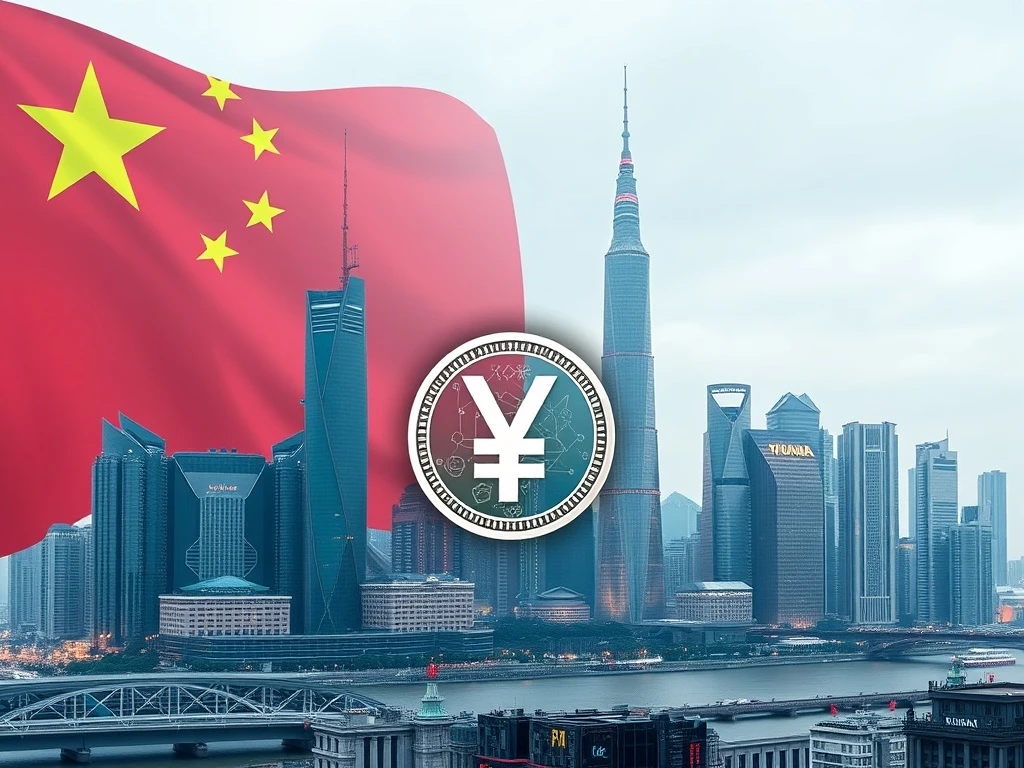Stablecoins: Shanghai’s Bold Move Unlocks New Hope Amidst China Crypto Ban

In a surprising turn of events, mainland China, known for its stringent stance on digital assets, appears to be softening its tone regarding stablecoins. This potential shift, spearheaded by officials in Shanghai, hints at a significant re-evaluation of the nation’s approach to cryptocurrencies. For those closely following the volatile world of digital finance, this development could signal a pivotal moment, especially considering the long-standing China crypto ban that has largely isolated the country from the global crypto market. Is China on the cusp of embracing a new digital currency future, or are these just preliminary discussions?
The Shifting Tides: Shanghai’s Stablecoin Revelation
Recent reports indicate a notable change in sentiment within China, particularly emanating from Shanghai. The Shanghai State-owned Assets Supervision and Administration Commission (SASAC), a powerful government body, recently convened a meeting to strategically discuss responses to stablecoins and other digital currencies. This move alone is remarkable, given the prevailing regulatory environment. Following this pivotal Thursday meeting, He Qing, the director of SASAC, emphasized the need for “greater sensitivity to emerging technologies and enhanced research into digital currencies.” This statement, shared on the authority’s official account, underscores a growing internal recognition of the transformative potential of these assets.
This initiative isn’t isolated. It reportedly emerged in response to increasing calls from both experts and major Chinese corporations. These entities advocate for the development of a yuan stablecoin, pegged directly to China’s national currency. Such a development could have profound implications for global trade and finance, potentially offering an alternative to existing dollar-pegged stablecoins and bolstering the international use of the yuan.
Why Yuan Stablecoin Adoption Matters
The concept of a yuan stablecoin is not merely about creating another digital currency; it’s a strategic play on the global economic stage. For China, embracing a yuan-backed stablecoin could:
- Enhance Global Payments: Facilitate more efficient and cost-effective international transactions, bypassing traditional banking systems.
- Boost Yuan’s Internationalization: Increase the Chinese yuan’s footprint in global trade and finance, challenging the long-standing dominance of the U.S. dollar.
- Foster Digital Economy Innovation: Position China as a leader in digital currency innovation, even amidst its domestic crypto restrictions.
- Support Cross-Border Trade: Offer a streamlined digital medium for trade settlements, particularly within the Belt and Road Initiative.
Companies like JD.com and Ant Group have reportedly been pushing for such a development, recognizing the competitive edge it could provide in the digital commerce landscape. The strategic importance of such a digital asset cannot be overstated, especially as nations globally explore central bank digital currencies (CBDCs) and the broader utility of stablecoins.
Navigating the China Crypto Ban: Regulatory Pathways
The prevailing China crypto ban has been comprehensive, targeting everything from mining operations to cryptocurrency trading and initial coin offerings (ICOs). This strict stance has largely pushed crypto activities offshore or underground. However, the recent discussions in Shanghai suggest that stablecoins might be viewed through a different lens than volatile cryptocurrencies like Bitcoin or Ethereum.
Officials appear to be considering a nuanced approach, differentiating between speculative digital assets and stable, asset-backed digital currencies that could serve practical economic purposes. This potential regulatory pathway could involve:
- Government-Backed Issuance: A stablecoin directly issued or heavily regulated by state entities, ensuring control and compliance.
- Controlled Environments: Piloting stablecoin use in specific economic zones or for particular industries, rather than a nationwide rollout.
- Focus on Utility: Prioritizing the use of stablecoins for cross-border payments and trade finance over speculative investment.
The emphasis on “enhanced research” indicates a cautious, data-driven approach to understanding how stablecoins can be integrated without undermining existing financial stability or capital controls.
The PBOC’s Stance: Weighing Global Crypto Regulation China
China’s central bank, the People’s Bank of China (PBOC), has been closely observing the global adoption of stablecoins, particularly in light of U.S. policy aims to strengthen the dollar’s power through assets like Circle’s USDC. PBOC Governor Pan Gongsheng reportedly acknowledged the transformative potential of emerging technologies, including stablecoins, in global payment systems back in June. This recognition from such a high-level official is a significant indicator of shifting perspectives within China’s financial leadership regarding crypto regulation China.
This evolving viewpoint is not just confined to official statements. On June 23, China’s state media, Securities Times, published an article advocating for the development of stablecoins “sooner rather than later.” Such an endorsement from state-backed media signals a broader discussion and potential policy consensus forming behind the scenes. The discourse suggests that while the overarching China crypto ban remains, there is a clear appetite to explore digital currency innovations that align with national economic interests.
Hong Kong: A Potential Sandbox for Yuan Stablecoins
One of the most pragmatic suggestions to emerge from these discussions involves Hong Kong. PBOC adviser Huang Yiping reportedly proposed exploring Hong Kong as a testing ground for yuan-backed stablecoins. This idea stems from Hong Kong’s unique position as an offshore market for the renminbi (RMB).
Huang highlighted that mainland China’s tight capital controls make direct experimentation with a yuan stablecoin unlikely within its borders. However, Hong Kong offers a viable alternative due to its established offshore RMB market. “Hong Kong has an offshore market for the renminbi, and if the offshore market develops, it is possible to create a stablecoin pegged to the offshore RMB in Hong Kong in the future,” Huang explained. This strategy would allow China to experiment with a yuan stablecoin in a controlled, external environment, gathering valuable insights without immediately impacting the mainland’s financial system.
This approach aligns with Hong Kong’s growing efforts to establish itself as a regional crypto hub, providing a bridge between China’s stringent regulations and the global digital asset market. It represents a clever way for Shanghai crypto proponents to push forward with innovation while respecting existing mainland policies.
What This Means for the Future of Digital Currencies
The warming stance of Shanghai officials towards stablecoins, despite the ongoing China crypto ban, marks a fascinating chapter in the global digital currency narrative. It underscores a strategic pivot where China, while maintaining tight control over speculative crypto, recognizes the indispensable role stablecoins could play in modernizing its financial infrastructure and enhancing its global economic influence.
The discussions surrounding a yuan stablecoin, the PBOC’s evolving perspective on crypto regulation China, and the potential of Hong Kong as a testing ground, collectively paint a picture of a nation cautiously but deliberately exploring its options in the digital asset space. This isn’t an overnight reversal of policy, but rather a calculated exploration of a specific type of digital asset that could serve China’s strategic interests. As these developments unfold, the world will be watching to see if this cautious optimism from Shanghai truly unlocks a new era for digital currencies in China.








